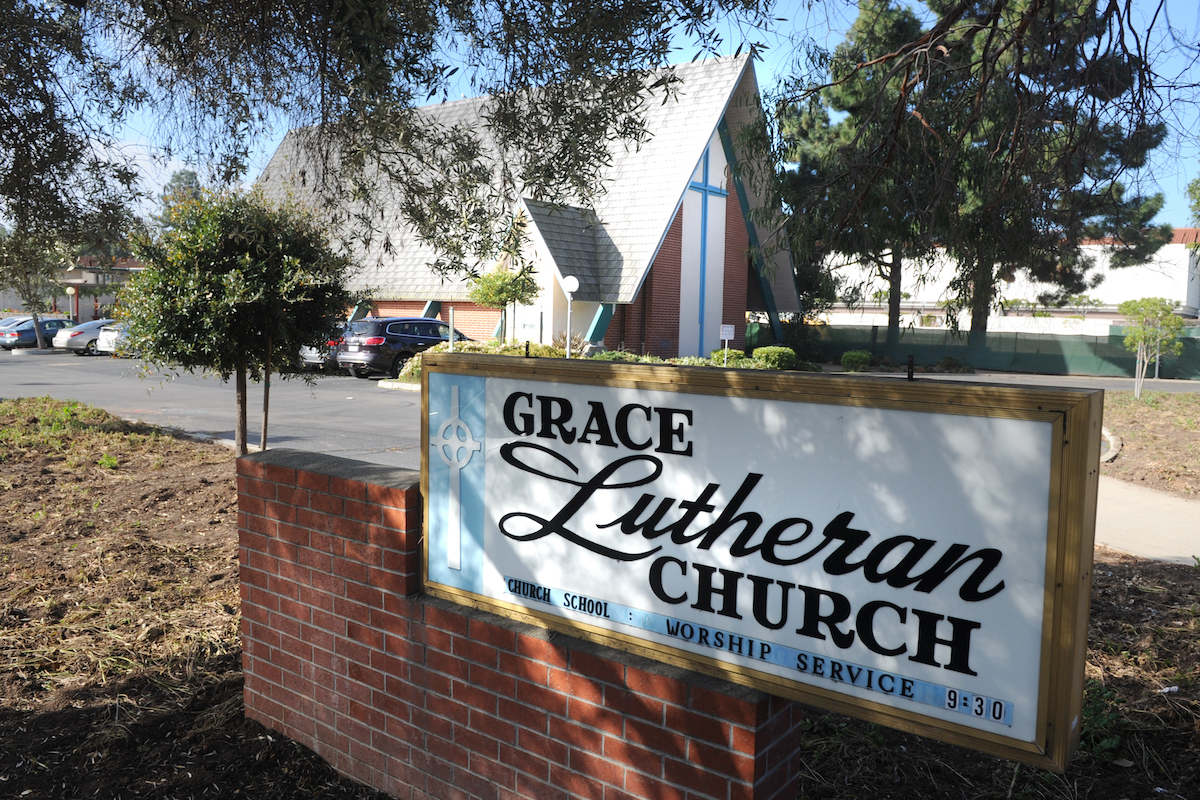Poodle | Santa Barbara Housing Crisis: Devoured by Our Own Tail
Can Churches and Golf Courses Be Our Salvation?

LET THE GAMES BEGIN: A few weeks ago, a self-enamored entrepreneurial dude brah developer from Chicago that no one had ever heard of quietly — but very loudly — declared a unilateral preemeptive war on renters in Isla Vista. That’s when Marc Lifshin and his company, Core Spaces, bought four Isla Vista apartment buildings that combine to form a complex known as “CBC & the Sweeps” for $91 million. A day later eviction notices were in the mail to the 550 occupants of the Sweeps who now find themselves at risk of being swept away. About half of these people, we are told by Supervisor Laura Capps’s assistant Jordan Killebrew, are families. Likewise, we are told there are no obvious legal remedies at the tenants’ disposal or that of the county supervisors.
It’s not clear to what extent appeals to Lifshin’s human decency might work. According to what I’ve read in the business press, Lifshin is a not-so-young-man-anymore in a very big hurry. He and his company are intent on becoming “The Google of Student Housing.” In Berkeley, he’s attempting to build a 26-story Taj Majal of student housing on Shattuck Avenue. The business plan is to either build new housing or to buy relatively low-end student housing. “We create extraordinary lifestyle experiences,” the company’s website boasts. The goal, according to the website, is to “create a better life for everyone under our roof.”
But in the meantime, you have to push out those already under that roof.
We’ve reached — once again — a historical fork in the road where we have to decide between the grape or the cucumber. For those wondering what the hell I’m talking about, grapes and cucumbers loomed large in primate experiments conducted about 15 years ago that demonstrated capuchin monkeys have a keen sense of fairness and injustice. Capuchin monkeys — known for big brains and a high degree of social cooperation — were happy to perform menial tasks in exchange for cucumbers, which they liked. But they got upset and went on strike when they saw other capuchin monkeys getting paid in grapes, which they liked much better.

It’s worth noting that the monkeys getting the grapes were perfectly happy with the arrangement. But similar experiments performed on chimpanzees — our closest relatives among primates — showed that chimps who got the better deal were troubled by the apparent inequity, and they rebelled.
Scientists concluded that chimps — even those getting the long end of the experimental stick — understood their long-term survival depends on cooperation and that cooperation depends upon a sense of fairness. In other words, survival of the fittest — at least for species like ours — relies upon an animal sense of altruism. That’s the real law of the jungle that operators like Lifshin violate.
The question for all the grape eaters among us is whether we want to tap into our inner chimp or our inner capuchin?
All this is exploding at exactly the same time that every government agency with a smidgen of land-use authority is now under intense pressure from the State of California to come up with realistic plans to cannibalize any existing farmland for new housing. And for good reason. Next week, the Santa Barbara County supervisors will have their first crack at crafting the new Housing Element; the proceeding promise to be long and contentious. The Good Land is in open revolt, also for good reason. The county, Goleta feels, hopes to satisfy the state’s demand for housing by savaging ag lands adjacent to Goleta. This is not a win-win situation.
Sign Up to get Nick Welsh’s award-winning column, The Angry Poodle delivered straight to your inbox on Saturday mornings.
As a card-carrying member of the peanut gallery, I’d like to make a few suggestions. Did you know that on the South Coast alone, golf courses occupy 857 acres of otherwise buildable land? There are 1,100 golf courses in the state, about one-quarter of which are publicly owned. Not being a golfer myself, I am quick to embrace every cheap and easy stereotype that dogs — maybe unfairly — the sport. Tiger Woods notwithstanding, golf seems to be disproportionately dominated by rich white elitists itching for an excuse to get out of the house and wear outrageously loud clothes.
In other words, golf is as close to drag as some people can get without reading storybooks to kids.
Eight hundred and fifty-seven acres!
Though there has been a resurgence during COVID, golf has been in serious wane the past 20 years. The number of golfers playing more than eight rounds a year had declined dramatically. Industry magazines report 200 golf courses go out of business a year. In our increasingly workaholic world, who has the time anymore? Do we really need all 857 acres?

| Credit: Paul Wellman (file)
The answer to that question is don’t mess with golfers. To the extent they play a dying sport, they’re swinging on the back nine in a radioactively passionate state of denial. When the State Assembly briefly considered a bill last year to make grant funding available so cities could simply ponder the planning logistics of converting from golf to housing, the golf mafia went berserk. The measure was quickly pulled and died a quick and messy exsanguination.
Closer to home, county planners have experienced a similar vehemence from golfers pissed off that anyone would suggest transforming Goleta’s 176-acre Glen Annie Golf Club — technically zoned for ag — into housing. Theoretically — if one didn’t worry about such things as one-eyed newts or terminal congestageddon — one could shoehorn 1,536 potential units on the site. The golfing community — don’t dare call them a cult — flipped its collective lid. Already county planners have received 174 letters of opposition. By contrast, they received only 39 letters against a proposal to rezone ag land on South Patterson.
I learned the hard way never to argue with anyone wielding a nine iron.
If golfers can legitimately pretend their sport has waged a resurgence during COVID, our houses of worship cannot. For the first time ever, less than half of all Americans attend church regularly. Twenty years ago, the number was closer to 70 percent. Given that California has 38,000 acres of church-owned property — I don’t know how many we have here — this seems like a promising approach. Because most churches own their property outright and are exempt from paying property taxes, they could afford to build truly affordable housing, not the bogus “affordability” we achieve by giving developers big density bonuses in exchange for paltry commitments — 10 to 20 percent — of below-market units.
A few years ago, the aging congregation of Grace Lutheran on outer State Street recognized their days were numbered and worked a deal with the Housing Authority. From that, we got 58 units of one-bedroom housing — all of which are affordable. In fact, there’s a movement out there; it’s called “Yes, in God’s Back Yard.”
Amen.

For all you finger waggers out there who want to blame the environmental movement for the housing crisis, I’d point out that Governor Jerry Brown and the State Legislature exacerbated things by decapitating Redevelopment Agencies statewide in 2011. That constituted a loss of about $1.5 billion that was used to build affordable housing. For every buck of redevelopment money our city Housing Authority got, they use it to leverage 10 more. That’s how affordable housing gets built, not by accepting whatever crumbs private developers are inclined to give. And no, it didn’t help that when Ronald Reagan — yes, a Santa Barbara property owner — was elected president, he slashed spending on affordable housing by 70 percent.
And if you really want to get into the weeds of how we feed the rich and starve the poor, consider this: The total subsidy for affordable housing in the United States is about $53 billion. The total subsidy for people buying market-rate homes — allowing market-rate homeowners to claim tax deductions for the interest they pay on the mortgages — is closer to $190 billion. You can do the math yourselves; people who can afford to buy a home are subsidized four time more than those who can’t afford to rent.
The question remains, a grape or cucumber? A capuchin or chimpanzee? As you do the evolutionary math, consider that the United States is the only advanced economy on Planet Earth where average life expectancies are actually falling. Survival of the fittest anyone?
Just remember what Marie Antionette said before they cut off her head. “Let them eat cucumbers!”




You must be logged in to post a comment.